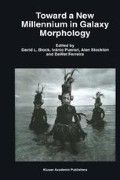Abstract
Deep galaxy counts are among the best constraints on the cosmic star formation history (SFH) of galaxies. Using various tracers, the evolution of the star formation activity may now be followed on a wide range of redshifts (0 ≤ z ≤ 4) covering most of the history of the Universe. Two incompatible interpretations of the observations are currently competing. After applying star formation rate (SFR) conversion factors to the CFRS, Hα or ISO samples, many authors conclude to a strong increase (≃ a factor 10) of the SFR from z = 0 to z = 1. They also find some evidence for a peak at z ≃ 1 and for a rapid decrease at higher redshifts. On the other side, the Hawaii deep surveys favor only a mild increase between z = 0 and 1 (Cowieet et al., 1996, 1999). In this paper, we tackle this problem from the point of view of the modelist of the spectral evolution of galaxies. To understand the reason for these discrepant interpretations, we consider three classes of galaxies: E/SO (‘early-type’); Sa-Sbc (‘intermediate-type’); Se-Sd, irregulars and bursting dwarfs (‘late-type’). We use the new version of our evolutionary synthesis code, Pégase (Floc and Rocca-Volmerange, 2000, in preparation), which takes into account metallicity and dust effects. The main results are: i) Late-type galaxies contribute significantly to the local SFR, especially bursting dwarfs (Fioc and Rocca-Volmerange, 1999). Because of that, the cosmic SFR can not decrease by a factor 10 from z = I to O. This is in agreement with Cowie et al., 1999’s result. ii) The SFR of intermediate-type galaxies has strongly decreased since z = 1. Though the decrease is less than what find Lilly et al., 1996, this suggests that the CFRS and Ha surveys are dominated by such bright early spirals. The limits in surface brightness and magnitudes of the observed samples may be the main reason for this selection. iii) The contribution of early-type galaxies increases rapidly from z = 1 to their redshift of formation (≥ 2-3 for cosmological reasons). Their intense star formation rates at high-z give strong constraints on early ionization phases, primeval populations or metal enrichments.
Access this chapter
Tax calculation will be finalised at checkout
Purchases are for personal use only
Preview
Unable to display preview. Download preview PDF.
References
Armand C. and Milliard B.: 1994, Astron & Astrophys 282, 1.
Aussel H., Elbaz D., Cesarsky C.J. and Starck J.L.: 1999, The Universe seen by ISO, P. Cox and M. Kessler, eds, ESA publications Division, p. 1023.
Bressan, A., Chiosi, C. and Fagotto, F.: 1994, Astrophysical J. Sup S. 94 94, 63.
Connolly A.J., Szalay, A.S., Dickinson, M., Subbarao, M.U. and Brunner, R.J.: 1997 Astrophysical J. 486, L 11.
Cowie, L.L., Songaila, A. and Barger, A.J.: 1999, Astronomical J. 118, 603.
Cowie, L.L., Songaila, A., Hu, E.M. and Cohen, J.G.: 1996, Astronomical J. 112, 839.
Draine, B.T. and Lee, H.M.: 1984, Astrophysical J. 405, 685.
Fioc, M. and Rocca-Volmerange, B.: 1997, Astron. & Astrophys. 326, 950.
Fioc, M. and Rocca-Volmerange, B.: 1999a, Astron & Astrophys. J. 344, 393.
Fioc, M. and Rocca-Volmerange, B.: 1999b, Astron & Astrophys. 351, 869.
Fioc, M. and Rocca-Volmerange, B.: 1999c, astro-ph/9912179.
Flores, H., Hammer, F., Thuan, T.X., Cesarsky, C., Désert, F.X., Omont, A., Lilly, S., Eales, S., Crampton, D. and Le Fèvre, O.: 1999, Astrophysical J 517, 148.
Fukugita, M., Yamashita, K., Takahara, F. and Yoshii, Y.: 1990, Astrophysical J. 361, L1.
Gallego, J., Zamorano, J., Aragon-Salamanca, A. and Rego, M.: 1995, Astrophysical J. 455, L1.
Groenewegen, M.A.T. and de Jong, T.: 1993, Astron & Astrophys. 267, 410.
Guiderdoni, B. and Rocca-Volmerange, B.: 1990, Astron & Astrophys. 227, 362.
Heyl, J., Colless, M., Ellis, R. and Broadhurst, T.: 1997 M.N.R.A.S. 285, 613.
Koo, D.C.: 1990, in Evolution of the Universe of Galaxies, ASP conf. ser. 10, p. 268.
Kurucz, R.: 1993, ASP conference Series, 44, M. Dworetsky, F. Castelli and R. Faraggiana, R., eds.
Lejeune, T., Cuisinier, F. and Buser, R.: 1997, Astron & Astrophys Sup S. 125, 229.
Lilly, S.J., Le Fèvre, O., Hammer, F. and Crampton, D.: 1996, Astrophysical J. 460, L1.
Madau, P., Ferguson, H., Henry, C., Dickinson, M.E., Giavalisco, M., Steidel, C. and Fruchter, A.: 1996, M.N.R.A.S. 283, 1388.
Marzke, R., Geller, M., Huchra, J. and Corwin, H.: 1994, Astron. J. 108, 437.
Pozzetti, et al.; 1998, M.N.R.A.S. 298, 1133.
Rocca-Volmerange, B. and Fioc., M.: 2000, in preparation.
Rocca-Volmerange, B. and Guiderdoni, B.: 1990, M.N.R.A.S. 247, 166.
Sullivan, M., Treyer, M.A., Ellis, R.S., Bridges, T.J., Millard, B. and Donas, J.: astroph/9910104.
Tresse, L. and Maddox, S.: 1998, Astrophys. J. 495, 691.
Treyer, M.A., Ellis, R.S., Milliard, B., Donas, J. and Bridges, T.: 1998, M.N.R.A.S. 300, 303.
Williams, R.E., et al.: 1996, Astronomical J. 112, 1335.
Yoshii, Y. and Peterson, B.: 1991, Astrophysical J. 372, 8.
Author information
Authors and Affiliations
Editor information
Editors and Affiliations
Rights and permissions
Copyright information
© 2000 Springer Science+Business Media Dordrecht
About this chapter
Cite this chapter
Rocca-Volmerange, B., Fioc, M. (2000). The Star Formation History as a Function of Type: Constraints from Galaxy Counts. In: Block, D.L., Puerari, I., Stockton, A., Ferreira, D. (eds) Toward a New Millennium in Galaxy Morphology. Springer, Dordrecht. https://doi.org/10.1007/978-94-011-4114-7_17
Download citation
DOI: https://doi.org/10.1007/978-94-011-4114-7_17
Publisher Name: Springer, Dordrecht
Print ISBN: 978-94-010-5801-8
Online ISBN: 978-94-011-4114-7
eBook Packages: Springer Book Archive

